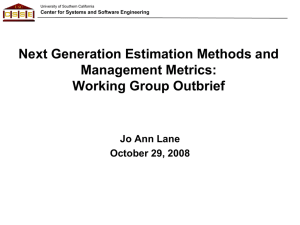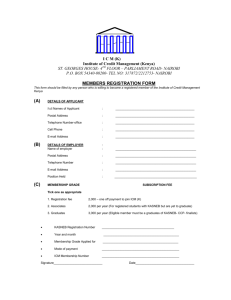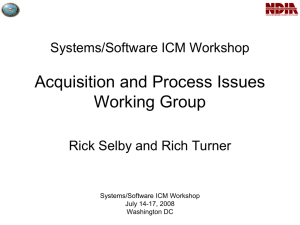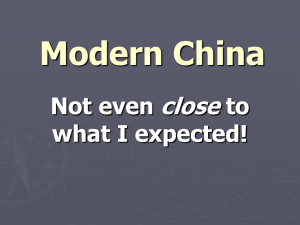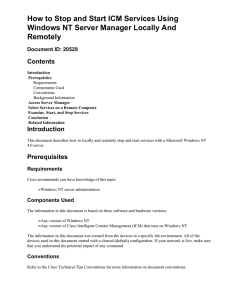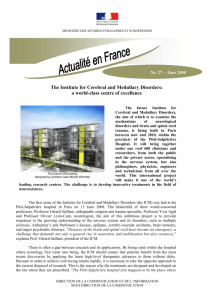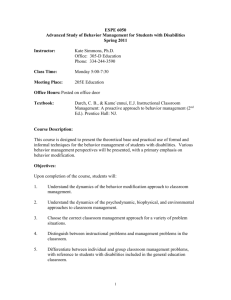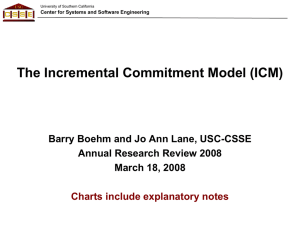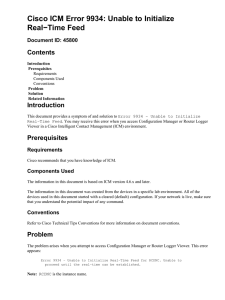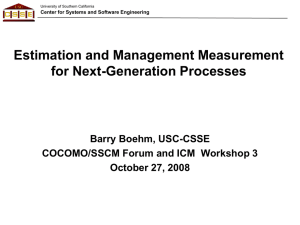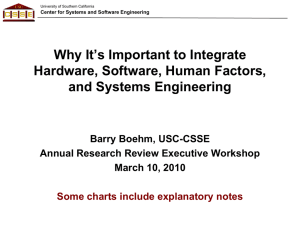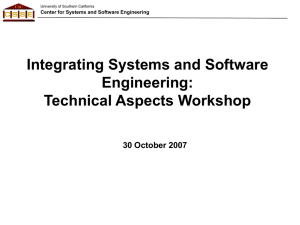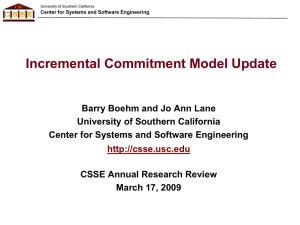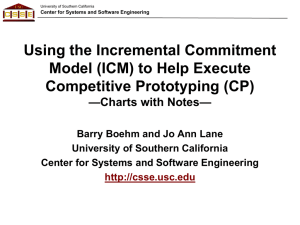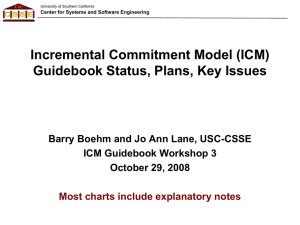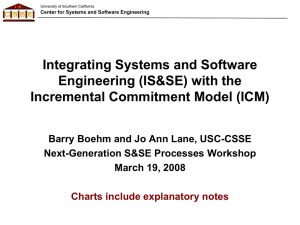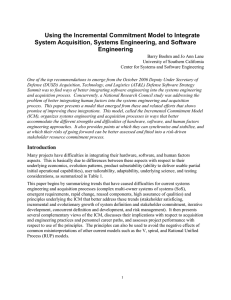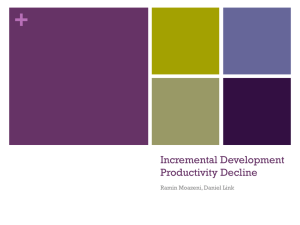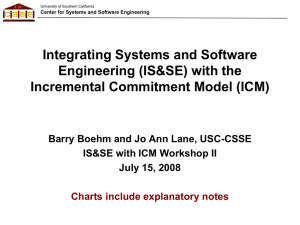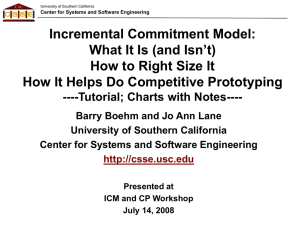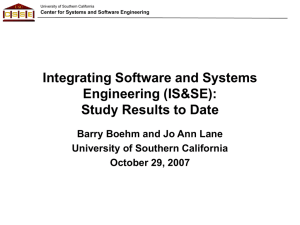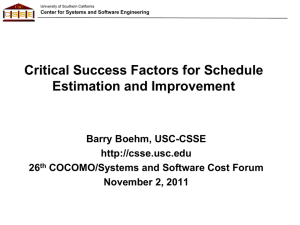4_Boehm ISSEwithICM-July08LLd
advertisement
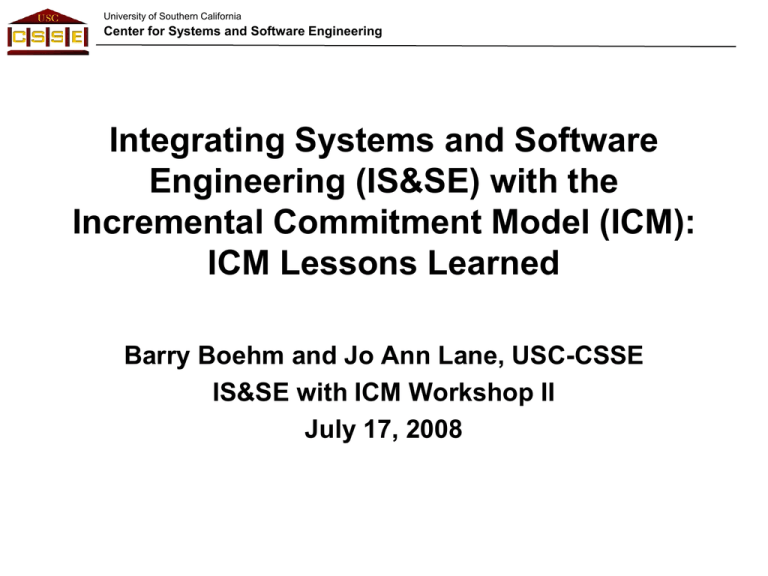
University of Southern California Center for Systems and Software Engineering Integrating Systems and Software Engineering (IS&SE) with the Incremental Commitment Model (ICM): ICM Lessons Learned Barry Boehm and Jo Ann Lane, USC-CSSE IS&SE with ICM Workshop II July 17, 2008 University of Southern California Center for Systems and Software Engineering ICM Assumptions and Critical Success Factors • The project can establish milestones at which it can synchronize and stabilize its elements – May exclude some classes of systems of systems • Ad-hoc, collaborative, some acknowledged – But ICM principles can be applied to tailor variants • The project can invest enough up front to generate and evaluate feasibility evidence and address risks • The project can acknowledge and manage its risks – Risk-taking essential for many classes of projects • Unprecedentedness, emergence, rapid change, immature technology • DARPA: 100% success rate is not doing your job • Commercial: 40% failure rate acceptable for new ventures 15 July 2008 ©USC-CSSE 2 University of Southern California Center for Systems and Software Engineering Example: SoSE Synchronization Points FCR1 SoS-Level Exploration Valuation Candidate Supplier/ Strategic Partner n DCR1 Architecting OCR1 Develop OCR2 Operation LCO-type Proposal & Feasibility Info ● Source Selection Rebaseline/ Adjustment FCR1 ● ● Candidate Supplier/ Strategic Partner 1 OCRx2 OCRx1 System x Develop OCRx3 Operation Operation OCRx5 OCRx4 Operation Operation DCRC OCRC1 ● ● ● System C FCRC Exploration Valuation Architecting FCRB System B Exploration Valuation 3 Exploration Valuation DCRB Architecting FCRA System A Develop Operation OCRB1 Develop July 2008 OCRB2 Operation OCRA1 DCRA Architecting OCRC2 Develop Operation ©USC-CSSE University of Southern California Center for Systems and Software Engineering Recognizing Authority/Responsibility Mismatch Collaborative Acknowledged SoS Ad-hoc SoS SoS Directed SoS Responsibility Infeasible Traditional Methods Authority 4 18 June 2007 ©USC-CSSE University of Southern California Center for Systems and Software Engineering How Much Architecting is Enough? Percent of Time Added to Overall Schedule - Larger projects need more 100 90 10000 KSLOC 80 Percent of Project Schedule Devoted to Initial Architecture and Risk Resolution 70 Added Schedule Devoted to Rework (COCOMO II RESL factor) Total % Added Schedule 60 Sweet Spot 50 40 100 KSLOC 30 Sweet Spot Drivers: 20 Rapid Change: leftward 10 KSLOC 10 High Assurance: rightward 0 0 10 20 30 40 50 60 Percent of Time Added for Architecture and Risk Resolution 03/19/2008 ©USC-CSSE 5 University of Southern California Center for Systems and Software Engineering ICM Assumptions and Critical Success Factors - II • The program office has enough expertise to evaluate feasibility evidence and assess risks – If not in-house, need to contract for it • Feasibility evidence is a first-class deliverable – Needs plans, EVMS monitoring of progress vs. plans • Appropriate contracting mechanisms and incentive structures are available for executing ICM approach – Concurrent stabilized development, change rebaselining, V&V – Collaborative systems of systems – Competitive prototyping • Representative examples are needed to clarify concepts – Ideally, success stories with excursions to show pitfalls 15 July 2008 ©USC-CSSE 6 University of Southern California Center for Systems and Software Engineering ICM Stage II: Increment View A radical idea? Unforseeable Change (Adapt) Rapid Change Short Development Increments Agile Future Increment Baselines Rebaselining for Future Increments Deferrals Foreseeable Change (Plan) Increment N Baseline Stable Development Increments Current V&V High Assurance Resources Short, Stabilized Development of Increment N Artifacts Increment N Transition/O&M Concerns V&V of Increment N Future V&V Resources Continuous V&V No; a commercial best practice and part of DoDI 5000.2 15 July 2008 ©USC-CSSE 7 University of Southern California Center for Systems and Software Engineering Bottom Line • Tremendously valuable workshop – Complementary perspectives, but remarkable compatibility – Value of insights much broader than ICM • Better understanding of underlying assumptions – Not every program fits the basic ICM/DoD milestone framework – But ICM principles can be applied to tailor variants – Need to clarify expectations, especially for SoSs • Rework chapter on application to SoSs • Rework overview to define assumptions and implications • Increase effort on representative examples – Will inform content of guidelines – Looking for good examples to use, further feedback on content • Will post results on Workshop web site – And establish ICM work-in-progress web site for review – Look forward to your participation in Oct 29-30 USC workshop 15 July 2008 ©USC-CSSE 8
